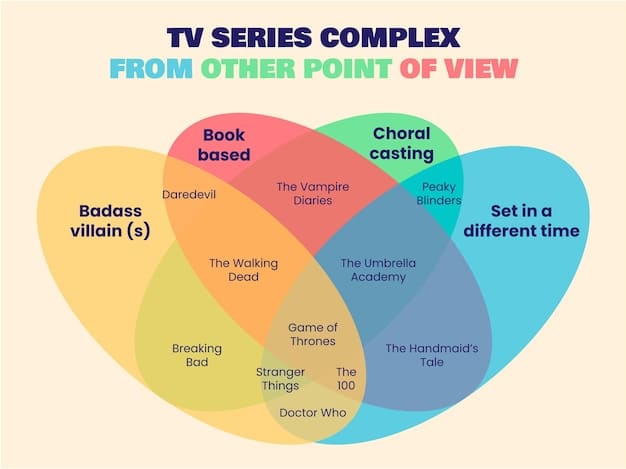Theatrical vs. Streaming: Film Release Strategies in 2025

Theatrical vs. Streaming: Comparing Release Strategies for Major Films in 2025 examines the evolving landscape of film distribution, analyzing how studios are adapting to changing consumer habits and technological advancements by experimenting with theatrical releases, streaming platforms, and hybrid models.
The future of film distribution is in constant flux. Let’s explore the dynamic world of theatrical vs. streaming: comparing release strategies for major films in 2025, examining how studios are adapting to shifts in audience behavior and technological advancements.
The Shifting Sands of Film Distribution in 2025
The film industry is no stranger to change, but the last few years have brought about a period of unprecedented transformation. The rise of streaming services has fundamentally altered how audiences consume movies, forcing studios to rethink their traditional release strategies. As we look ahead to 2025, the battle between theatrical releases and streaming platforms is set to intensify, with major studios experimenting with new and innovative distribution models.
Understanding these shifting dynamics is crucial for anyone interested in the future of cinema. This section will delve into the factors driving these changes and explore the challenges and opportunities that lie ahead.
The Rise of Streaming Giants
Streaming services like Netflix, Amazon Prime Video, and Disney+ have disrupted the traditional film distribution model by giving viewers access to a vast library of content from the comfort of their homes. This convenience has attracted millions of subscribers worldwide, leading to a significant decline in theatrical attendance.
The Impact of the Pandemic
The COVID-19 pandemic accelerated the shift towards streaming, as movie theaters were forced to close, and studios began releasing films directly on streaming platforms. While some theaters have reopened, many viewers have grown accustomed to watching movies at home, making it difficult to lure them back to the big screen.

Consider these factors:
- The increasing production value of shows has leveled the field, offering competition to big budget movie releases.
- The overall convenience and comfort of in-home viewing.
- Streaming bundles that offer consumers access to multiple services and a wide variety of content.
In conclusion, the landscape has changed radically and continues to shift as we approach 2025. A radical shift in how films are viewed and consumed is underway.
The Allure of Theatrical Releases
Despite the rise of streaming, theatrical releases still hold significant value for major film studios. A successful theatrical run can generate substantial revenue, build buzz, and enhance a film’s prestige. For some filmmakers, the cinematic experience remains the ideal way to showcase their work, offering a level of immersion and scale that cannot be replicated at home.
This section examines the key advantages of theatrical releases and explores how studios are working to revitalize the cinema experience.
The pros that keep them around:
- Higher Revenue Potential: Blockbuster films can generate hundreds of millions, if not billions, of dollars in theatrical revenue.
- Cultural Impact: The shared experience of watching a movie in a theater can create a sense of community and cultural relevance.
- Award Consideration: Theatrical releases are often a prerequisite for major awards, such as the Oscars.
Despite challenges, theatrical releases continue to play a vital role in the film industry.
Hybrid Release Strategies: A Balancing Act
Faced with the rise of streaming and the enduring appeal of theatrical releases, many studios have adopted hybrid release strategies that combine elements of both approaches. These strategies can take many forms, including releasing a film simultaneously in theaters and on streaming platforms, offering early access to streaming subscribers, or shortening the theatrical window before a film becomes available online.
The most common hybrid release options are:
Here are some advantages and disadvantages of hybrid release models:
- Simultaneous Release: Releasing a film simultaneously in theaters and on streaming platforms can maximize its reach, but it can also cannibalize theatrical revenue.
- Early Streaming Access: Offering early access to streaming subscribers can incentivize sign-ups, but it can also alienate theatergoers.
- Shortened Theatrical Window: Shortening the theatrical window can increase the availability of films online, but it can also reduce theatrical revenue.
The key to a successful hybrid strategy is finding the right balance between maximizing revenue and meeting the needs of different types of viewers.

The Economic Realities: Box Office vs. Streaming Revenue
The financial equation for film releases is complex, involving factors such as production costs, marketing expenses, and revenue streams from various sources. Studios must carefully weigh the potential returns from box office receipts, streaming subscriptions, and ancillary markets such as home video and merchandise.
Understanding the economic realities of film distribution is essential for predicting future trends and making informed decisions about release strategies.
A closer look into:
- Theatrical Revenue: Box office receipts are a significant source of revenue for major films, but they are subject to fluctuations based on factors such as film quality, competition, and audience demand.
- Streaming Revenue: Streaming revenue is generated through subscription fees, advertising, and transactional video-on-demand (TVOD) services.
- Ancillary Markets: Ancillary markets such as home video, merchandise, and international distribution can contribute significantly to a film’s overall revenue.
Studios must carefully analyze these numbers when deciding on release strategies.
Consumer Behavior: How Audiences Choose to Watch
Ultimately, the success of any film release strategy depends on how audiences choose to watch movies. Factors such as price, convenience, and the desire for a shared social experience all play a role in shaping consumer behavior.
Studying consumer behavior is crucial for understanding the evolving preferences of moviegoers and tailoring release strategies to meet their needs.
Price Sensitivity
Price is a major factor influencing consumer behavior. Streaming subscriptions offer a relatively affordable way to access a vast library of content, while theatrical tickets can be expensive, especially for families.
Convenience
Another factor is convenience as streaming provides a viewing experience from the comfort of one’s home.
Social Experience
And lastly, the social experience of watching a movie in a theater can be a powerful draw for some viewers. The shared laughter, gasps, and tears that accompany a theatrical screening can create a sense of community and connection.
The key to success is understanding these motivations and tailoring release strategies.
Looking Ahead: The Future of Film Distribution in 2025
As we look ahead to 2025, the film industry is likely to continue experimenting with new and innovative release strategies. The balance between theatrical releases and streaming platforms will depend on a variety of factors, including the ongoing evolution of consumer behavior, the financial performance of different distribution models, and the creative vision of filmmakers.
This section will offer some predictions and insights into the future of film distribution, based on current trends and emerging technologies.
Some final insight:
Consider these aspects:
- Virtual Reality (VR): VR technology could provide a more immersive and engaging cinematic experience, potentially blurring the lines between theatrical and streaming releases.
- Interactive Storytelling: Interactive storytelling techniques could allow viewers to shape the narrative of a film, creating a more personalized and engaging experience.
- Personalized Distribution: Algorithms could be used to tailor release strategies to individual viewers, offering them the option to watch a film in theaters, on streaming platforms, or through other channels based on their preferences and viewing habits.
The future of film releases is bright with possibilities.
| Key Point | Brief Description |
|---|---|
| 🎬 Theatrical Releases | Offer high revenue potential & cultural impact. |
| 📱 Streaming Services | Provide convenience and a vast content library. |
| ⚖️ Hybrid Strategies | Balance theatrical and streaming approaches. |
| 💰 Economic Realities | Box office vs. streaming revenue matter to profitability. |
[FAQ]
▼
No, theatrical releases aren’t likely to disappear entirely. They continue to offer unique cultural events and high revenue potential.
▼
These strategies combine theatrical and streaming releases, like day-and-date releases, or shortened theatrical windows.
▼
Streaming revenue comes from subscription fees and advertising, providing a continuous income stream for studios.
▼
Consumers still go to theaters for the social experience and to enjoy movies on a large screen with high-quality audio.
▼
VR, interactive storytelling, and personalized distribution could transform how movies are released and experienced.
Conclusion
The future of film distribution in 2025 will depend on the ability of studios to balance the appeal of theatrical releases with the convenience of streaming platforms. Experimentation with hybrid strategies, innovative technologies, and a deep understanding of consumer behavior will be key to success in this evolving landscape.





